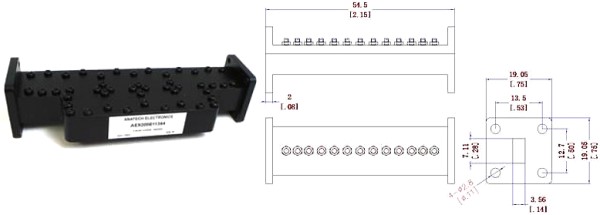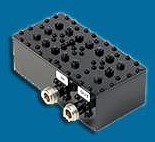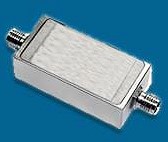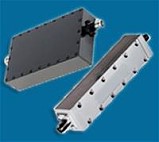|

Sam Benzacar of Anatech Electronics, an RF and microwave filter company, has published
his March 2022 newsletter that features his short op-ed entitled "Will CBRS Private
Networks Take Off?," where he discusses the pros and cons of moving to the
Citizens Broadband Radio Service licensed frequency band (which means paying a
usage fee) versus remaining in the licensee-free Wi-Fi spectrum. According to
Sam, benefits include greater security, less interference, and lower latency for
real-time processes. The biggest negative (other than having to pay for
it) is the relatively narrow bandwidth that can limit data rates. CBRS private
networks are only now being deployed.
A Word from Sam Benzacar
Will CBRS Private Networks Take Off?
 By Sam Benzacar By Sam Benzacar
As companies throughout the world move tepidly into deploying IoT, they can now
add another line item in their budget: private networks based on either LTE or 5G
that operate in licensed spectrum. This came about in 2017 when the FCC released
the Citizens Broadband Radio Service (CBRS) spectrum (Band 48), and any type of
device can be used from smartphones to laptops and even IoT devices.
The benefits are that licensed frequencies that the company must acquire provide
a significantly lower level of interference potential than Wi-Fi, and as transmitter
RF output power is higher, they deliver far greater range, and this potentially
means that fewer base stations will be required. The customer also gets the benefit
of excellent (although not impregnable) security, although Wi-Fi security today
is vastly superior to its predecessors and will no doubt advance in the future.
Other potential benefits include low latency, which is essential for most real-time
applications, and the ability to dramatically scale up the network if needed.
Not surprisingly, the major wireless carriers, as well as Amazon and others,
have jumped on the private 5G bandwagon and offering packaged services that include
everything from the required spectrum to hardware, installation, cloud data service,
and management and operational support. That said, there is plenty of speculation
about whether CBRS will prove to be a formidable competitor to entrenched solutions
such as Wi-Fi and combinations of short-range wireless protocols, low-power wireless
area networks (LPWANs), and other alternatives.
It's also important to remember that the CBRS band is 150 MHz wide, which isn't
that much considering the high data rates that must be accommodated. In contrast,
Wi-Fi 6 is 160 MHz wide and Wi-Fi 6E that adds spectrum at 6 GHz, so Wi-Fi already
offers plenty of bandwidth for data-hungry applications such as virtual reality
and other streaming applications.
As always, the main issue comes down to cost, and as CBRS private networks are
only now being deployed, I haven't been able to nail this down with reasonable accuracy,
as it obviously varies with the size and complexity of what the customer wants.
I suspect it will be very high but that said, to be competitive these networks cannot
be too expensive because there are certainly alternatives.
We can always find a solution!
3G Coming to an End
 After two decades,
major wireless carriers are finally turning off 3G. AT&T led the way when it
shut down its 3G service on February 22 and T-Mobile will follow it on March 31.
Although Verizon says that less than 1% of its subscribers still use its 3G network,
smartphones aren't the only devices affected. For example, auto navigation systems,
alarm systems, early e-readers, medical alert dongles, baby monitors, and many legacy
loT devices still rely on these networks for data. Open Signal reported that in
2019 about 30 million people in the U.S. were still using 3G, so if any of these
devices rely solely on wireless networks rather than WI-FI, services will simply
disappear. Even before the "sunset" date, many users will experience a decrease
in performance as the number of base stations with 3G capability continually decreases.
In addition, utility companies have been using 3G for many years and have optimized
their equipment based in the standard. After two decades,
major wireless carriers are finally turning off 3G. AT&T led the way when it
shut down its 3G service on February 22 and T-Mobile will follow it on March 31.
Although Verizon says that less than 1% of its subscribers still use its 3G network,
smartphones aren't the only devices affected. For example, auto navigation systems,
alarm systems, early e-readers, medical alert dongles, baby monitors, and many legacy
loT devices still rely on these networks for data. Open Signal reported that in
2019 about 30 million people in the U.S. were still using 3G, so if any of these
devices rely solely on wireless networks rather than WI-FI, services will simply
disappear. Even before the "sunset" date, many users will experience a decrease
in performance as the number of base stations with 3G capability continually decreases.
In addition, utility companies have been using 3G for many years and have optimized
their equipment based in the standard.
Northrop Grumman Developing SEWIP "Lite"
 Northrop Grumman is moving
forward to develop a "lite" version of its AN/SLQ-32(V)7 Surface Electronic Warfare
Improvement Program Block III upgrade (SEWIP Block III) that it's building for the
Navy. This smaller version is designed to provide the latest EW capabilities for
smaller vessels, including simultaneous advance passive RF detection of multiple
threats. The capabilities of SEWIP Block III Lite should help these small craft
respond to threats from anti-ship missiles, UAVs, and ships, while also providing
secondary multi-mode radar and broadband communications. The system employs machine
learning and AI that can analyze known and unknown waveforms, and as it is built
using an open-source software and hardware architecture, it can be upgraded in place
as new threats emerge. Northrop Grumman is moving
forward to develop a "lite" version of its AN/SLQ-32(V)7 Surface Electronic Warfare
Improvement Program Block III upgrade (SEWIP Block III) that it's building for the
Navy. This smaller version is designed to provide the latest EW capabilities for
smaller vessels, including simultaneous advance passive RF detection of multiple
threats. The capabilities of SEWIP Block III Lite should help these small craft
respond to threats from anti-ship missiles, UAVs, and ships, while also providing
secondary multi-mode radar and broadband communications. The system employs machine
learning and AI that can analyze known and unknown waveforms, and as it is built
using an open-source software and hardware architecture, it can be upgraded in place
as new threats emerge.
Report: Retailers Will Use 5 in Stores
 Most U.S. retailers
expect the use of 5G in their stores to rapidly increase in the next three years
as the retail industry is moving toward a more "digital experience," according to
a study conducted by Verizon and market research firm Incisiv. The study showed
that 93% of retailers expect the use of smartphones in their stores will spike in
the next few years. Some respondents also expressed concern about the ability to
handle the data traffic this will generate, so they might rely on private hybrid
5G networks. Verizon and Incisiv claim that 5G will be necessary for most retailers
as they compete to provide customers with the best in-store experiences, and the
number of cloud-based store applications spikes in the next few years. Most U.S. retailers
expect the use of 5G in their stores to rapidly increase in the next three years
as the retail industry is moving toward a more "digital experience," according to
a study conducted by Verizon and market research firm Incisiv. The study showed
that 93% of retailers expect the use of smartphones in their stores will spike in
the next few years. Some respondents also expressed concern about the ability to
handle the data traffic this will generate, so they might rely on private hybrid
5G networks. Verizon and Incisiv claim that 5G will be necessary for most retailers
as they compete to provide customers with the best in-store experiences, and the
number of cloud-based store applications spikes in the next few years.
DoD Launches New Initiative to Enhance Participation of Small Business
 The Department
of Defense is about to launch an imitative to make it easier for small businesses
to service contractors. According to Defense News, the number of small businesses
receiving contracts has been declining in the last decade because the barriers to
entry are formidable. The plan comes on the heels of a pledge by Deputy Secretary
of Defense, Kathleen Hicks, to create more opportunities for small companies, especially
those unfamiliar with defense contracting. She noted that the number of contractors
has declined by more than 40%. The Department
of Defense is about to launch an imitative to make it easier for small businesses
to service contractors. According to Defense News, the number of small businesses
receiving contracts has been declining in the last decade because the barriers to
entry are formidable. The plan comes on the heels of a pledge by Deputy Secretary
of Defense, Kathleen Hicks, to create more opportunities for small companies, especially
those unfamiliar with defense contracting. She noted that the number of contractors
has declined by more than 40%.
Getting Ready for 5G:
Anatech Electronics introduce New Ka band 30.5 GHz Waveguide Band Pass Filter.
Featuring a center frequency of 30.5 GHz, a bandwidth of 1000 MHz, an Insertion
Loss 1 dB Max, and a Power Handling is 20 watts.

Anatech Electronics Introduces a New Line of Suspended Stripline and
Waveguide Type RF Filters
Check out Our Filter Products



Cavity Band Pass Filters
LC Band Pass Filters Cavity Bandstop/Notch Filter
About Anatech Electronics
Anatech Electronics, Inc. (AEI) specializes in the design and manufacture of
standard and custom RF and microwave filters and other passive components and subsystems
employed in commercial, industrial, and aerospace and applications. Products are
available from an operating frequency range of 10 kHz to 30 GHz and include cavity,
ceramic, crystal, LC, and surface acoustic wave (SAW), as well as power combiners/dividers,
duplexers and diplexers, directional couplers, terminations, attenuators, circulators,
EMI filters, and lightning arrestors. The company's custom products and capabilities
are available at www.anatechelectronics.com.
Contact:
Anatech Electronics, Inc.
70 Outwater Lane
Garfield, NJ 07026
(973) 772-4242
sales@anatechelectronics.com
Posted March 17, 2022
|





























 By Sam Benzacar
By Sam Benzacar After two decades,
major wireless carriers are finally turning off 3G. AT&T led the way when it
shut down its 3G service on February 22 and T-Mobile will follow it on March 31.
Although Verizon says that less than 1% of its subscribers still use its 3G network,
smartphones aren't the only devices affected. For example, auto navigation systems,
alarm systems, early e-readers, medical alert dongles, baby monitors, and many legacy
loT devices still rely on these networks for data. Open Signal reported that in
2019 about 30 million people in the U.S. were still using 3G, so if any of these
devices rely solely on wireless networks rather than WI-FI, services will simply
disappear. Even before the "sunset" date, many users will experience a decrease
in performance as the number of base stations with 3G capability continually decreases.
In addition, utility companies have been using 3G for many years and have optimized
their equipment based in the standard.
After two decades,
major wireless carriers are finally turning off 3G. AT&T led the way when it
shut down its 3G service on February 22 and T-Mobile will follow it on March 31.
Although Verizon says that less than 1% of its subscribers still use its 3G network,
smartphones aren't the only devices affected. For example, auto navigation systems,
alarm systems, early e-readers, medical alert dongles, baby monitors, and many legacy
loT devices still rely on these networks for data. Open Signal reported that in
2019 about 30 million people in the U.S. were still using 3G, so if any of these
devices rely solely on wireless networks rather than WI-FI, services will simply
disappear. Even before the "sunset" date, many users will experience a decrease
in performance as the number of base stations with 3G capability continually decreases.
In addition, utility companies have been using 3G for many years and have optimized
their equipment based in the standard. Northrop Grumman is moving
forward to develop a "lite" version of its AN/SLQ-32(V)7 Surface Electronic Warfare
Improvement Program Block III upgrade (SEWIP Block III) that it's building for the
Navy. This smaller version is designed to provide the latest EW capabilities for
smaller vessels, including simultaneous advance passive RF detection of multiple
threats. The capabilities of SEWIP Block III Lite should help these small craft
respond to threats from anti-ship missiles, UAVs, and ships, while also providing
secondary multi-mode radar and broadband communications. The system employs machine
learning and AI that can analyze known and unknown waveforms, and as it is built
using an open-source software and hardware architecture, it can be upgraded in place
as new threats emerge.
Northrop Grumman is moving
forward to develop a "lite" version of its AN/SLQ-32(V)7 Surface Electronic Warfare
Improvement Program Block III upgrade (SEWIP Block III) that it's building for the
Navy. This smaller version is designed to provide the latest EW capabilities for
smaller vessels, including simultaneous advance passive RF detection of multiple
threats. The capabilities of SEWIP Block III Lite should help these small craft
respond to threats from anti-ship missiles, UAVs, and ships, while also providing
secondary multi-mode radar and broadband communications. The system employs machine
learning and AI that can analyze known and unknown waveforms, and as it is built
using an open-source software and hardware architecture, it can be upgraded in place
as new threats emerge.  Most U.S. retailers
expect the use of 5G in their stores to rapidly increase in the next three years
as the retail industry is moving toward a more "digital experience," according to
a study conducted by Verizon and market research firm Incisiv. The study showed
that 93% of retailers expect the use of smartphones in their stores will spike in
the next few years. Some respondents also expressed concern about the ability to
handle the data traffic this will generate, so they might rely on private hybrid
5G networks. Verizon and Incisiv claim that 5G will be necessary for most retailers
as they compete to provide customers with the best in-store experiences, and the
number of cloud-based store applications spikes in the next few years.
Most U.S. retailers
expect the use of 5G in their stores to rapidly increase in the next three years
as the retail industry is moving toward a more "digital experience," according to
a study conducted by Verizon and market research firm Incisiv. The study showed
that 93% of retailers expect the use of smartphones in their stores will spike in
the next few years. Some respondents also expressed concern about the ability to
handle the data traffic this will generate, so they might rely on private hybrid
5G networks. Verizon and Incisiv claim that 5G will be necessary for most retailers
as they compete to provide customers with the best in-store experiences, and the
number of cloud-based store applications spikes in the next few years.  The Department
of Defense is about to launch an imitative to make it easier for small businesses
to service contractors. According to Defense News, the number of small businesses
receiving contracts has been declining in the last decade because the barriers to
entry are formidable. The plan comes on the heels of a pledge by Deputy Secretary
of Defense, Kathleen Hicks, to create more opportunities for small companies, especially
those unfamiliar with defense contracting. She noted that the number of contractors
has declined by more than 40%.
The Department
of Defense is about to launch an imitative to make it easier for small businesses
to service contractors. According to Defense News, the number of small businesses
receiving contracts has been declining in the last decade because the barriers to
entry are formidable. The plan comes on the heels of a pledge by Deputy Secretary
of Defense, Kathleen Hicks, to create more opportunities for small companies, especially
those unfamiliar with defense contracting. She noted that the number of contractors
has declined by more than 40%. 





